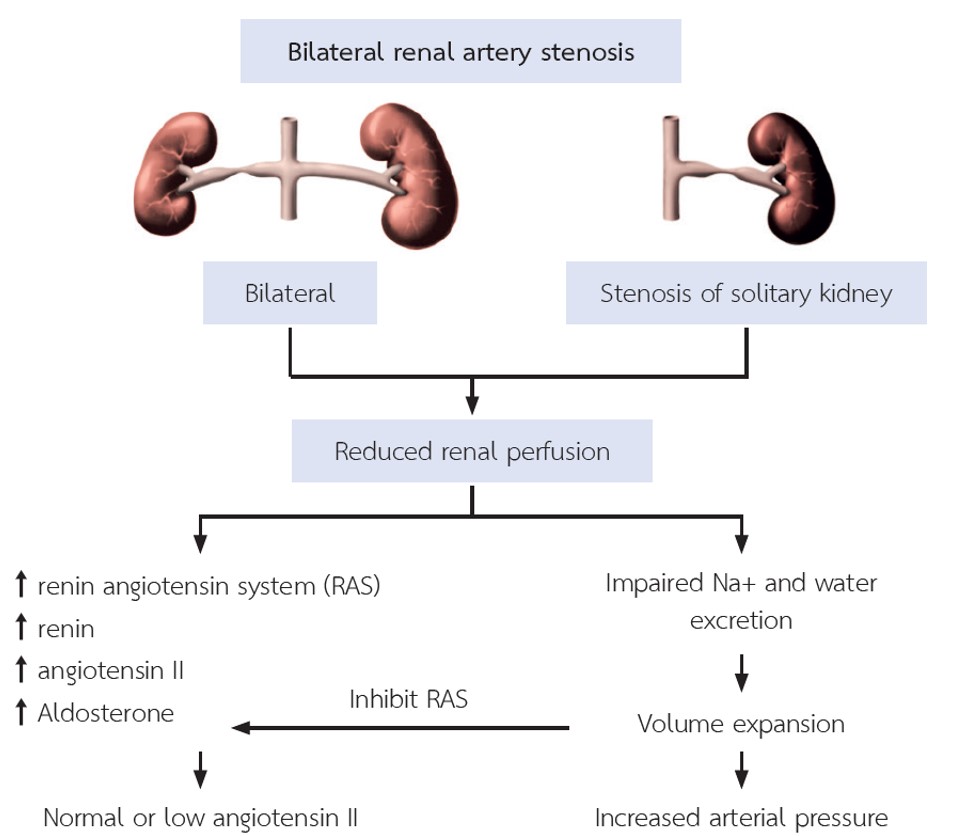Renovascular Hypertension
Main Article Content
Abstract
Currently, the evaluation of treatment for hypertension due to abnormal renal artery conditions involves a multidisciplinary medical team, including nephrologists, cardiologists, radiologists, and vascular surgeons. This is because patients with hypertension caused by abnormal renal arteries often exhibit a variety of symptoms, which can lead to cardiovascular complications, resulting in increased morbidity and potentially higher mortality rates. From the past to the present, there have been randomized controlled trials comparing the treatment of hypertension due to abnormal renal arteries using medication versus angioplasty with stent placement. The results of these studies remain inconclusive due to significant limitations in each study. This review aims to compile information on the pathology, clinical symptoms, diagnostic criteria, and current treatment guidelines to provide physicians and researchers with a comprehensive understanding, enabling them to further study the topic or apply this knowledge in patient care.
Article Details

This work is licensed under a Creative Commons Attribution-NonCommercial-NoDerivatives 4.0 International License.
This article is published under CC BY-NC-ND 4.0 license, which allows for non-commercial reuse of the published paper as long as the published paper is fully attributed. Anyone can share (copy and redistribute) the material in any medium or format without having to ask permission from the author or the Nephrology Society of Thailand.
References
Hooton T, Johnson RJ, Feehally J, Floege J. Comprehensive clinical nephrology / [edited by] John Feehally, Jurgen Floege, Marcello Tonelli, Richard J. Johnson. 6th ed. Edinburgh: Elsevier; 2019.
Bhalla V, Textor SC, Beckman JA, Casanegra AI, Cooper CJ, Kim ESH, et al. Revascularization for Renovascular Disease: A Scientific Statement From the American Heart Association. Hypertension. 2022;79(8):e128-e43.
Carey RM, Calhoun DA, Bakris GL, Brook RD, Daugherty SL, Dennison-Himmelfarb CR, et al. Resistant Hypertension: Detection, Evaluation, and Management: A Scientific Statement From the American Heart Association. Hypertension. 2018;72(5):e53-e90.
Goldblatt H, Lynch J, Hanzal RF, Summerville WW. Studies on Experimental Hypertension: I. The Production of Persistent Elevation of Systolic Blood Pressure by Means of Renal Ischemia. J Exp Med. 1934;59(3):347-79.
Yu ASL, Chertow GM, Luyckx V, Marsden PA, Skorecki K, Taal MW. Brenner and Rector’s The Kidney. 11th ed. Elsevier; 2019.
Aboyans V, Ricco J-B, Bartelink M-LEL, Björck M, Brodmann M, Cohnert T, et al. 2017 ESC Guidelines on the Diagnosis and Treatment of Peripheral Arterial Diseases, in collaboration with the European Society for Vascular Surgery (ESVS): Document covering atherosclerotic disease of extracranial carotid and vertebral, mesenteric, renal, upper and lower extremity arteriesEndorsed by: the European Stroke Organization (ESO)The Task Force for the Diagnosis and Treatment of Peripheral Arterial Diseases of the European Society of Cardiology (ESC) and of the European Society for Vascular Surgery (ESVS). Eur Heart J. 2018;39(9):763-816.
Plouin P-F, Bax L. Diagnosis and treatment of renal artery stenosis. Nat Rev Nephrol. 2010;6(3):151-9.
Xiong H-L, Peng M, Jiang X-J, Che W-Q, Dong H, Chen Y, et al. Time trends regarding the etiology of renal artery stenosis: 18 years’ experience from the China Center for Cardiovascular Disease. J Clin Hypertens (Greenwich). 2018;20(9):1302-9.
Hicks CW, Clark TWI, Cooper CJ, de Bhailís Á M, De Carlo M, Green D, et al. Atherosclerotic Renovascular Disease: A KDIGO (Kidney Disease: Improving Global Outcomes) Controversies Conference. Am J Kidney Dis. 2022;79(2):289-301.
Bardelli M, Veglio F, Arosio E, Cataliotti A, Valvo E, Morganti A. New intrarenal echo-Doppler velocimetric indices for the diagnosis of renal artery stenosis. Kidney Int. 2006;69(3):580-7.
Granata A, Fiorini F, Andrulli S, Logias F, Gallieni M, Romano G, Sicurezza E, Fiore CE. Doppler ultrasound and renal artery stenosis: An overview. J Ultrasound. 2009;12(4):133-43.
Losito A, Errico R, Santirosi P, Lupattelli T, Scalera GB, Lupattelli L. Long-term follow-up of atherosclerotic renovascular disease. Beneficial effect of ACE inhibition. Nephrol Dial Transplant. 2005;20(8):1604-9.
ASTRAL Investigators; Wheatley K, Ives N, Gray R, Kalra PA, Moss JG, Baigent C, et al. Revascularization versus Medical Therapy for Renal-Artery Stenosis. N Engl J Med. 2009;361(20):1953-62.
Bax L, Woittiez A-JJ, Kouwenberg HJ, Mali WPTM, Buskens E, Beek FJA, et al. Stent Placement in Patients With Atherosclerotic Renal Artery Stenosis and Impaired Renal Function. Ann Intern Med. 2009;150(12):840-8.
Cooper CJ, Murphy TP, Cutlip DE, Jamerson K, Henrich W, Reid DM, et al. Stenting and Medical Therapy for Atherosclerotic Renal- Artery Stenosis. N Engl J Med. 2014;370(1):13-22.
Maz M, Chung SA, Abril A, Langford CA, Gorelik M, Guyatt G, et al. 2021 American College of Rheumatology/Vasculitis Foundation Guideline for the Management of Giant Cell Arteritis and Takayasu Arteritis. Arthritis Rheumatol. 2021;73(8):1349-65.


